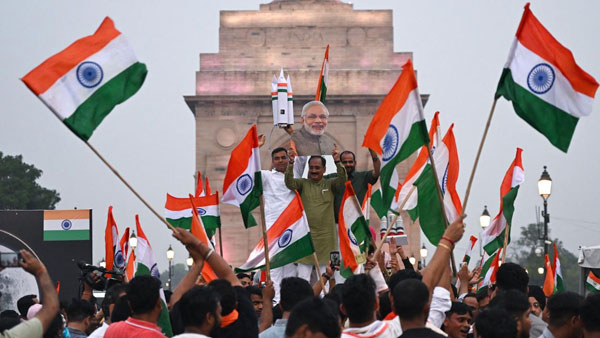Sunday Times 2
Reinventing the wheel 50 years later
View(s):Indians on the Moon were news for two weeks, and last week they were heading towards the Sun.
Space exploration is indeed a quest for knowledge and an evolutionary factor for Homo sapiens. But nationalism and geopolitics have inevitably been forces motivating space exploration, even though the lofty claim is often made that the sole motivating factor is the search for knowledge that would benefit all humanity.
The space race was a by-product of the race between the two superpowers of the last half of the 20th century—the United States and the Soviet Union—in the development of armed missiles, which threatened to blow up planet Earth in a nuclear holocaust. Even today, rocket power is symbolic of the military power of a nation such as Kim Jong Un’s Korea, where millions of people are undernourished, like even in the newly self-proclaimed world power, India.

Indians celebrate the Chandrayaan-3 spacecraft's successful landing on the moon's south pole. Picture: Arun Sankar/AFP
When the Indian satellite landed close to the South Pole of the Moon—not the other side—jubilant Indians were dancing in joy. Before that, ten countries and the European Union of Communications had landed satellites on the Moon, but the Indian achievement was that its satellite had a Moon rover that could roam the surface for days, analyse the soil and send back data—such as the possibility of finding ‘water on the Moon”—to its receivers in India. That was, per se, a singular scientific achievement.
The space race, though a by-product of the superpower rivalry over the past five decades, has developed into an industry with commercial interests as well as being symbolic of military and economic power for many nations.
This columnist has been an observer of the development of space science and technology for over 50 years and has vivid memories of the radio commentary broadcast on July 16, 1969, when Neil Armstrong and Edwin Buzz Aldrin landed on the Moon in a space vehicle after ejecting from a vehicle that was orbiting the Moon and was piloted by another astronaut, Mich Collins.
Lanka had no TV at that time, but the story that came over the crackling radio in our newsroom was the greatest human achievement ever.
The pictures we were able to view were only in the newspapers the next day.
The return of Armstrong and Aldrin in the vehicle in which they landed on the Moon, docking into the orbiting vehicle around the Moon, and splashing down unscathed in the Pacific Ocean on July 24 will be the greatest ever adventure of humanity until future space exploration does something better.
All this was achieved when electronics and other associated sciences could be described, as compared with today, in the preliminary stages of development. The basic concepts and technologies, from the booster rockets to the survival of humans in space and the heat shield for entering Earth’s atmosphere, were all NASA originals; we doubt whether there were any prototypes as used in today’s space-exploring countries.
The NASA programme resulted in 12 men walking on the Moon and bringing back 842 pounds (382kg) of lunar rock samples for analysis.
When Buzz Aldrin visited Sri Lanka, we covered his visit to Kandy. We recall a sample of Moon rocks being presented to Lanka and wonder where it ended up.
Recollection of this great American adventure and comparing it to what Indian scientists are attempting to do, such as finding evidence for water on the Moon, makes us wonder whether they are attempting to re-invent the space wheel fifty years later. Moon rocks brought back by NASA astronauts could possibly tell us all that. The jubilation over Chandrayaan 3’s attempts, with dancing at home, leaves us speechless, to say the least.
The Soviet Union, too, contributed much to the development of space research. The first man to orbit the Earth was Yuri Gagarin of the Soviet Union. This was attributed as the main reason for the American determination to land on the Moon first.
The Soviets officially denied any attempts to be the first to be on the Moon, although Americans claim that this attempt was given up following repeated failures. However, the Soviet Union openly declared its resolve not to send a man to the Moon but to build space stations to reach outer planets such as Mars and Venus. Soviet space stations are still being used by many nations today.
As stated earlier, space research inevitably gets intertwined with nationalism and geopolitics. But when the geopolitical factor unwinds itself, the research should be able to stand on its own and be recognised.
Geopolitics undergoes rapid transformation over time. China is not the same as that of Deng Xiaoping, nor is India that of Rajiv Gandhi.
(The writetr is a former editor of The Sunday Island, The Island and consultant editor of the Sunday Leader. He can be contacted at gamma.weerakoon@gmail.com)

